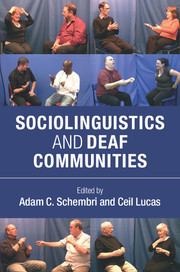Book contents
- Frontmatter
- Contents
- List of Figures
- List of Tables
- Notes on Contributors
- 1 Introduction
- 2 Sign languages in the world
- 3 Sign languages in contact
- 4 Variation and change in sign languages
- 5 Discourse analysis and sign languages
- 6 Language policy and planning in Deaf communities
- 7 Language attitudes in Deaf communities
- Index
- References
5 - Discourse analysis and sign languages
Published online by Cambridge University Press: 05 February 2015
- Frontmatter
- Contents
- List of Figures
- List of Tables
- Notes on Contributors
- 1 Introduction
- 2 Sign languages in the world
- 3 Sign languages in contact
- 4 Variation and change in sign languages
- 5 Discourse analysis and sign languages
- 6 Language policy and planning in Deaf communities
- 7 Language attitudes in Deaf communities
- Index
- References
Summary
Introduction
People often wonder what discourse analysis is and what the field of study includes. As a newer field, discourse analysis is still determining its own boundaries. It is different from traditional linguistics in several ways – it uses natural data for analysis, and it deals with utterances, as opposed to sentences. If you spend time observing everyday talk, you will notice that these utterances rarely look like those grammatical sentences seen in the grammar books and often described in linguistic research about syntax and grammar. In everyday interaction, people do not always use complete “sentences,” they leave out information, they add meaning with their voice, or their faces, and they leave their comments unfinished. Yet, we still understand each other. An utterance, then, is the real-life expression of people's thoughts, ideas, and feelings.
Simply put, discourse analysis is the study of language in use. In discourse analysis, we study how people interact by expressing meaning using language within a context. This includes much more than just studying the words or signs that make up an utterance. It includes all the aspects of those utterances: pacing, facial expression, body shifting, gestures, and any other features that add meaning to an utterance. It also includes building understanding one utterance at a time, from beginning to end, in real time.
Information
- Type
- Chapter
- Information
- Sociolinguistics and Deaf Communities , pp. 95 - 119Publisher: Cambridge University PressPrint publication year: 2015
